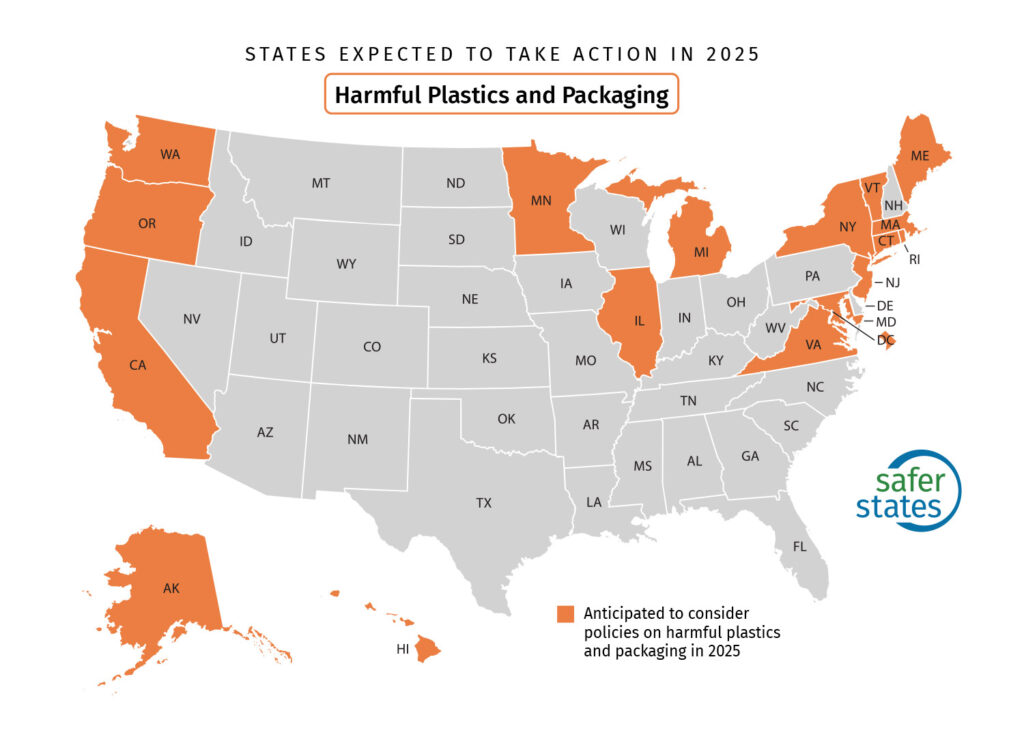Addressing harmful plastics and packaging
States have been at the forefront of tackling plastic-related hazards and pollution. Over a decade ago, states began phasing out harmful chemicals like bisphenols, phthalates, and other toxic chemicals used in plastics, initially focusing on products for children. In the past five years, there has been an expansion to include more policies addressing plastic packaging. While early state policies focused on mainly managing plastic waste, more recently the emphasis has expanded toward reducing unnecessary plastic packaging and addressing the toxicity of additives used in plastic. This year, several states are exploring measures to reduce plastic use, phase out the most problematic types of plastic such as polyvinyl chloride (PVC) and polystyrene, and regulate the most hazardous plastic additives.
Plastic and Plastic Additive Health Concerns
Almost all plastics are made from petrochemicals and can create toxic impacts throughout their lifecycle. As the plastic industry is projected to grow significantly, the impacts on the health of fenceline communities, workers, ecosystems, and consumers are an increasingly serious concern. The 2023 East Palestine train derailment, where four train cars carrying 115,000 gallons of the carcinogen vinyl chloride (a PVC building block) burned uncontrollably for several days, highlights the danger of making, transporting, using, and disposing of the chemicals in plastics.
The chemical building blocks of plastics are associated with health effects ranging from cancer and neurological harm to birth defects, immune system suppression, reproductive harm, hormone disruption, obesity, and asthma. In addition, the toxic chemicals found in plastics have also been linked to hormone disruption, impaired fertility, cancer, and developmental harm, among other health impacts. These toxic plastic chemicals can leach out from food packaging and other consumer products into our food, water, and indoor air. Moreover, plastic creates serious toxic impacts across its entire lifecycle, with low-income communities and communities of color most impacted.
A growing health concern with plastics is that they can break into tiny particles called microplastics. Microplastics have been found in food, water, air, and the human body, where they can carry toxic chemicals and absorb chemicals from the environment. Recent studies detected microplastics in human reproductive organs such as human testicles, raising concerns about potential threats to fertility and sperm quality. In addition to plastic particles breaking off of consumer products like clothing, paint, and tires, microplastics are intentionally added to certain consumer goods, including cosmetics and cleaning products. While research is still ongoing, a recent science review have raised concerns that they may impact fertility, increase the risk of cancer, and cause other health problems.
Meanwhile, the plastic and chemical industries continue to promote a set of technologies they refer to as “chemical recycling,” which have been criticized for their toxic environmental impacts, questionable effectiveness, and high energy demands. Reports from Beyond Plastic and NRDC have revealed that “chemical recycling” plants can generate significant hazardous waste as part of their operations.
Expected Plastics Policies and Regulations
This year, at least 17 states and the District of Columbia are likely to consider policies to address plastics and packaging. These states include Alaska, California, Connecticut, Hawaii, Illinois, Maine, Maryland, Massachusetts, Michigan, Minnesota, New Jersey, New York, Oregon, Rhode Island, Virginia, Vermont, and Washington.
